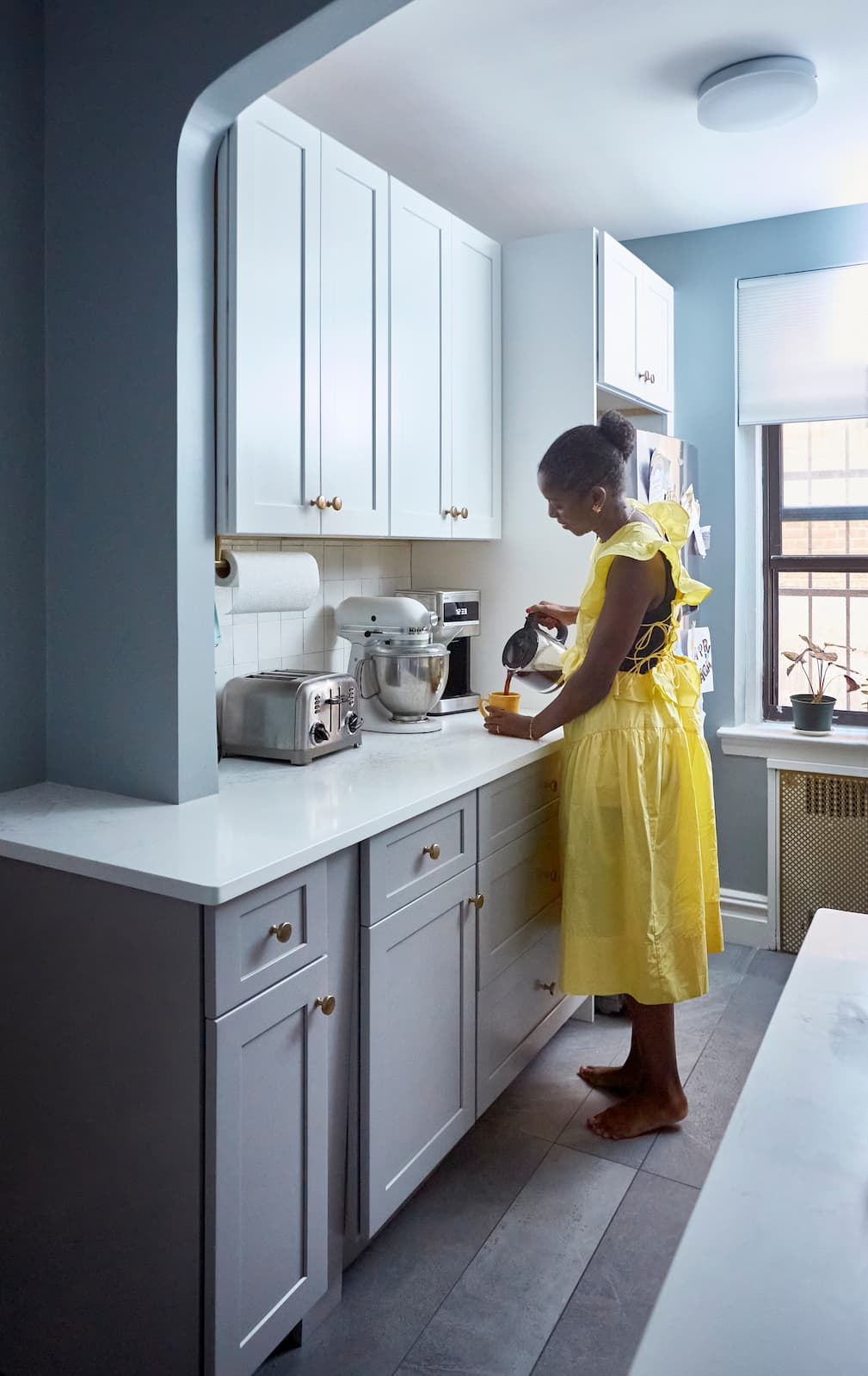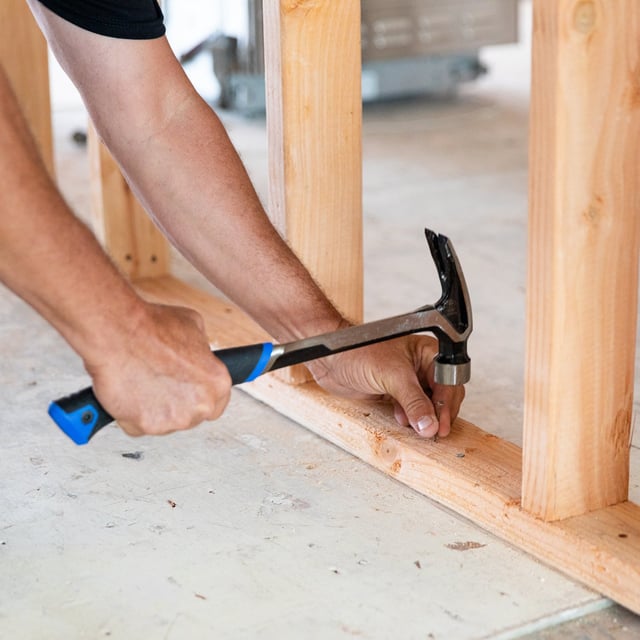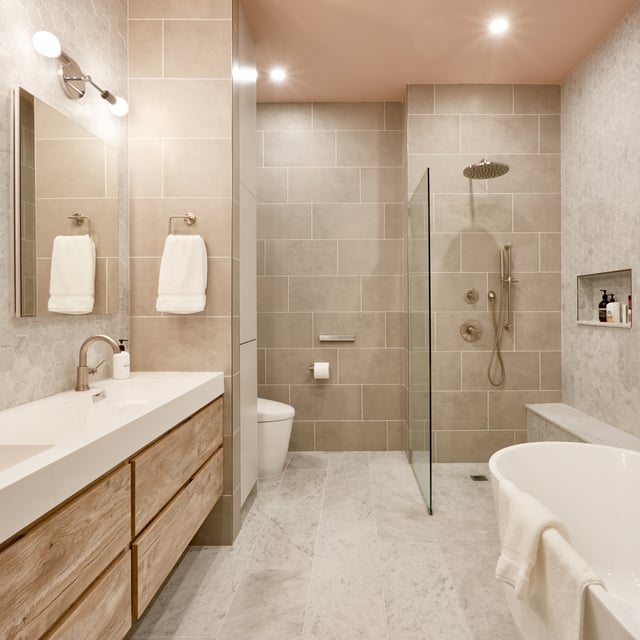
Laundry Room
Converting a Closet Into a Laundry Room
12.26.2025
Our New Year savings event is here: Get up to $6,500 off your project today (terms apply).

-1.jpg?width=640&name=A%20Complete%20Guide%20to%20Laundry%20Room%20Addition%20and%20Remodel%20(2024)-1.jpg)
In This Article
Transforming your laundry room can be a game-changer for any home, turning a necessary chore into a more enjoyable and efficient process. Whether you’re considering a full remodel, adding a brand-new space, or just looking for ways to maximize functionality, a well-designed laundry room can boost your home's value and convenience.
This guide covers everything you need to know, from estimating costs to selecting the right contractor and even considering DIY options. You’ll find a breakdown of factors that affect the cost, like flooring, cabinets, and appliances, as well as room-specific considerations—whether you’re thinking of renovating a basement laundry area or creating a compact laundry closet.
Plus, we’ll highlight the practical and financial benefits of having a dedicated laundry room, making it a feature that enhances everyday life while adding long-term value. Dive in to discover how a laundry room remodel can elevate your home and simplify your routines.
A laundry room remodel is an exciting yet significant investment. For a complete renovation, the average cost hovers around $8,000, but expenses can range widely from $1,000 for a small upgrade to $15,000 for a full-scale addition with customizations. The price range largely depends on the size of the room, quality of materials, extent of remodeling, and additional design elements.
If you're working within a budget, smaller changes like updating flooring, cabinets, or appliances are manageable with a lower cost ceiling. However, for those adding a new laundry room or making structural updates, the expenses can escalate quickly. Many homeowners find that a well-designed laundry room becomes a highly functional space that adds convenience and potentially boosts home value, making the investment worthwhile.
When it comes to adding or remodeling a laundry room, several things can impact the cost. First off, the size and layout of the space play a huge role. Bigger rooms or those that need structural changes will naturally come with higher material and labor costs. Then there’s the choice of appliances; opting for high-efficiency models or the latest features can definitely bump up the budget.
Here's a breakdown of essential elements to consider when planning your budget:
Flooring
Flooring in a laundry room is like the unsung hero of durability. It’s got to handle spills, detergent drips, and the endless shuffle of laundry baskets and feet. For this, you’ll want something that’s water-resistant and easy to clean. Popular choices are vinyl and ceramic tile—both of which check all the practical boxes, including the budget-friendly ones.
Expect to pay between $280 and $840 for your laundry room floor, depending on the materials you choose. Vinyl is a crowd-pleaser for its affordability, easy maintenance, and variety of designs (who doesn’t want a hardwood-look floor that’s spill-proof?). But if you’re looking for a little more elegance, ceramic tiles offer durability with a bit of upscale flair and are often more resistant to wear and tear in heavy-traffic areas.
Pro tip: Install flooring last, after the major construction is done, to avoid any accidental scratches, spills, or smudges on your new floor. There’s nothing worse than a fresh tile with construction scuffs all over it.
Subflooring
Subflooring may not be the glamorous part of your laundry room remodel, but it’s absolutely essential. Subflooring ensures your main floor remains sturdy, moisture-resistant, and able to handle the weight of your appliances. In essence, it’s the invisible foundation that keeps everything intact.
Subflooring costs range from $155 to $495. This is where spending a little extra on high-quality materials pays off because a solid subfloor prevents moisture problems, which is especially important in a laundry room where water is always in the mix. If you’re placing your laundry room on an upper floor, you’ll definitely want sturdy subflooring to avoid any issues.
Think of subflooring as the trusty sidekick to your main floor. It doesn’t get all the glory, but it’s holding everything together.
Cabinets
Laundry room cabinets are a game-changer for keeping your space neat and organized. They hide all those laundry essentials—detergents, dryer sheets, and stain removers—and make your laundry area look chic and functional. Depending on the materials and customizations you choose, cabinet installation can cost anywhere from $250 to $2,000.
Soft-close cabinets are all the rage in laundry rooms since they eliminate the noise of banging doors, adding a touch of luxury to even the most basic designs. You’ll find everything from budget-friendly stock cabinets to more upscale, custom-built options that can turn your laundry room into an organization station.
Pro tip: Adding pull-out shelves or bins can make sorting a breeze and keep everything looking clutter-free. These cabinets can also double as extra storage for other household items you want to keep out of sight but easily accessible.
Countertops
Countertops aren’t just for kitchens anymore. A laundry room countertop gives you a place to fold clothes, treat stains, and sort your colors from whites without having to juggle everything. Countertops in the laundry room generally cost between $300 and $1,400, depending on the material you choose.
Slate, limestone, Corian, and granite are all excellent options, with slate and limestone being more budget-friendly and granite giving a high-end, finished look. The key here is durability—since countertops are bound to see their fair share of spills and heavy loads, investing in a stain-resistant and sturdy material pays off.
If you want to keep the look cohesive with the rest of your home, pick a material that matches your kitchen or bathroom countertops. This will bring a little uniformity to your home’s design. Plus, it just looks cool.
Electrical
Electricity might not be the most exciting part of a laundry room, but it’s definitely one of the most important. Washers and dryers need special outlets (220V for dryers), and having the right setup for safety and functionality is essential. You can expect to spend about $160 for appliance wiring, $500 for outlets, and another $500 for light fixtures if you’re adding those to brighten things up.
If you’re considering a gas dryer, installation costs could go up, as you’ll need a line for gas hookups. However, gas dryers can be more energy-efficient, so it may save you money in the long run if you do a lot of laundry.
Pro tip: Always hire a licensed electrician for this part of the job. DIY electrical work may sound tempting, but it’s not worth the risk. With a licensed pro, you can be sure your setup meets safety standards and avoid potential issues later on.
Dryer ventilation
Ventilation in a laundry room is critical, especially for your dryer. Without proper ventilation, lint can build up, which not only makes your dryer work harder (hello, higher energy bills) but also poses a fire risk. Proper dryer ventilation costs around $400 to install, but it’s an investment in safety and efficiency.
A high-quality, smooth dryer vent keeps airflow strong, helping your dryer run more efficiently. Bob Tschudi, a contractor on Angi’s Expert Review Board, notes that “dryer vents clog quite easily, especially if the vents are not smooth.” Some areas even require specific vent types by code, so it’s wise to check in with your contractor about local requirements.
New appliances and installation
Adding new appliances to your laundry room remodel? Now we’re talking! But remember, the cost goes beyond just picking out a shiny new washer and dryer. Installing new appliances comes with its own set of expenses.
Here’s a quick breakdown:
And don’t forget an emergency water shut-off valve—it’s only about $20 but can prevent costly water damage if there’s ever a leak. This minor addition is one of those small details that can save a lot of hassle.
If you’re considering higher-end, energy-efficient models, keep in mind that while these appliances might cost more upfront, they can lead to energy savings over time. Modern washers and dryers come with all sorts of nifty features, from steam cycles to larger load capacities, so it’s worth investing in quality machines if you’re a frequent laundry doer.
Pro tip: Be mindful of delivery costs. Some stores include delivery and installation in the appliance price, while others charge extra. Checking for hidden fees can help you avoid surprises on your final bill.
Labor
Labor costs are where things can really vary, depending on the scope of your project. If you’re doing a basic remodel with minimal changes, you might pay around $40 to $200 per hour for labor. However, for full additions or extensive remodels involving new plumbing, electrical work, and structural changes, labor costs can jump to $200 to $350 per hour.
This price covers everything from carpentry and cabinet installation to plumbing and electrical work. It’s wise to get a clear contract outlining what’s included and confirm whether the contractor will bring in specialists for certain tasks. Labor costs can add up quickly, so it’s worth clarifying these details upfront.
Pro tip: To save on labor costs, consider tackling smaller tasks yourself, like painting or installing simple shelving. Leave the complex jobs, such as electrical and plumbing work, to the pros, but if you’re handy, a little DIY can go a long way toward keeping your budget in check.

Choosing where to add or remodel a laundry room in your home can significantly impact both convenience and costs. Each room type brings unique benefits and challenges, from extra plumbing for an upstairs laundry to simple space considerations in a garage setup. Here's a breakdown to help you find the best fit for your needs and budget.
Basement
Adding a laundry room to a basement is a common choice since it's out of the way, keeping laundry tasks from interfering with daily household activities. The average cost for a basement laundry remodel is about $7,500, covering everything from minor repairs and finishing to adding new appliances, cabinets, and shelving. Factors like existing water and electrical access can reduce costs, as moving these utilities can add to expenses.
Additionally, basements are prone to moisture, so homeowners may need to invest in waterproof flooring and ventilation to prevent mold or mildew; for more insights, check out Waterproofing a Basement: Cost Breakdown and Next Steps. Putting your laundry setup in this area can be practical for those already using their basement for storage, though transporting loads up and down stairs could be a downside.
Laundry closet
A laundry closet remodel is ideal for homes with limited space, such as apartments or condos. This option costs between $4,500 and $8,000, making it more budget-friendly than adding a full room. Laundry closets fit neatly into hallways, kitchens, or bathrooms, and they can even be integrated into larger rooms behind folding doors for a hidden, clean look.
With limited space, homeowners often maximize storage by stacking the washer and dryer, choosing smaller appliances, or using wall-mounted storage solutions. If the closet is located close to common areas, adding soundproofing around the closet's walls can also reduce noise.
Garage
The garage can be ideal for those who prioritize separating the laundry area from the main living space. The cost for a garage laundry setup typically ranges between $1,100 and $4,500, depending on existing structures, insulation, and appliance needs. Since the garage is generally unfinished, any extra finishes for weatherproofing, insulation, and new cabinetry or countertops can push costs to the higher end.
Homeowners who choose this option often benefit from ample space for folding and storage. However, factors like seasonal temperature variations and limited climate control in garages should be considered. Some choose to install simple heating or cooling systems to make the space more functional year-round.
Mudroom
Incorporating a laundry area into a mudroom combines two utility spaces, allowing you to handle dirty clothes or shoes in one area. The cost of a mudroom laundry room is between $4,025 and $8,750. Since mudrooms often have plumbing installed already, adding a washer and dryer can be relatively straightforward.
Homeowners may install additional cabinetry or benches for seating, giving the space dual functionality. Mudroom laundry rooms are often strategically located at the house entrance, making it easy to manage laundry right after entering the home. With this setup, consider adding durable flooring that can withstand both foot traffic and laundry tasks.
Upstairs
Installing a laundry room upstairs, closer to bedrooms and bathrooms, can add significant convenience, as it reduces the distance for carrying loads. However, this convenience can come at a higher price. Upstairs laundry room remodels often cost up to $15,000 due to added plumbing and electrical expenses.
Proper vibration control is critical in an upstairs laundry setup; adding features like anti-vibration pads or reinforced flooring can prevent disruptive noise. Additionally, ensuring waterproofing and proper drainage is essential to avoid potential leaks. For families with busy schedules, the proximity of an upstairs laundry room can be a major advantage.
Smart storage solutions can elevate a laundry room, making the space more organized and functional. Each storage option offers unique benefits, from closet systems to simple wall organizers. Here's a breakdown of popular storage types, their average costs, and practical advice on choosing the best fit.
Closet
A dedicated laundry closet provides a compact but highly effective storage solution, especially if space is limited. Depending on materials, features, and installation, a laundry closet setup typically costs $1,000 to $5,000. This setup usually includes a combination of cabinets, shelving, and perhaps even rod space for hanging clothes.
Laundry closets are versatile, as they can include pull-out racks, built-in hampers, and even slim cabinets for detergents and other cleaning products. Depending on your budget, opting for custom-built shelves and compartments can make your laundry closet feel tailored and polished. One thing to consider, however, is the door style. Sliding or folding doors are ideal for compact spaces, as they reduce the footprint when open and close off the area neatly.
Cubby
A cubby system is one of the most practical storage options for families, as it allows for easy organization and access to frequently used items. The cost for a cubby storage setup generally ranges from $200 to $1,200, with price variations depending on the material and number of cubbies. Basic cubby systems are affordable and use open shelving, while higher-end models include closed cubbies with doors for a more finished look.
Cubby storage often works best in mudrooms or larger laundry rooms where space allows for a bit of customization. Each cubby can be designated for a family member's laundry or specific items like detergents, fabric softeners, and even pet supplies. Many homeowners also find cubbies helpful for sorting laundry by type or color. For a modern look, some cubbies include wire baskets or bins that add both style and functionality, providing a flexible way to store items that may otherwise end up scattered around the room.
Shelving
Shelving is a staple in any laundry room and one of the most affordable and versatile storage solutions. Wall-mounted shelves, especially, provide additional storage without occupying floor space. Basic shelving costs around $50 to $300, but custom or high-quality options like floating wood shelves or glass can reach $500 or more.
There are many ways to make the most of shelving. Stackable bins and baskets can be placed on the shelves to keep smaller items organized and easily accessible. Adjustable shelves are also worth considering as they allow you to change the height between shelves to fit different-sized items, like taller laundry products or large storage baskets. Shelves are ideal for displaying commonly used items like detergents and dryer sheets. They can even serve as a space to showcase decorative elements, adding a personalized touch to the laundry room.
Wall organizer
Wall organizers are efficient for small laundry rooms or closet-style setups where every inch counts. Depending on complexity and quality, they range in price from $30 to $150, making them one of the most budget-friendly storage options. Wall organizers often include hooks, racks, and compartments that are perfect for holding items like ironing boards, cleaning brushes, or hanging tools.
For those who prefer a minimalist look, some wall organizers have a sleek, built-in appearance that blends with the room's decor while keeping essentials within reach. Installing one behind a door can make efficient use of space without cluttering up walls. If ironing is a regular chore, some wall organizers include a foldable ironing board or a designated rack for hang-drying clothes, adding both convenience and efficiency.
Adding a laundry room to your home might sound like a small tweak, but it’s a real game-changer for both daily life and long-term value. Imagine a world where laundry stays in its own designated space—no more stray socks in the living room, no detergent bottles taking over the kitchen. With a laundry room, everything is organized, accessible, and out of sight.
This space is more than just practical; it’s a hidden gem for extra storage. With custom cabinetry and shelving, your laundry room can double as a storage spot for linens, cleaning products, and even the ironing board. Built-in hampers, drying racks, and a folding station? Now that’s a well-oiled laundry machine—literally. Suddenly, the chaos of laundry day is contained, with each item in its place.
And let’s not forget about resale value. A dedicated laundry room gives your home a boost in the eyes of potential buyers. It screams, "This home is organized and ready for action!" In competitive real estate markets, a tidy, functional laundry space can be a real selling point. So, adding one isn’t just about making laundry less of a chore—it’s about adding value and a little extra polish to your whole home.
When thinking about a laundry room addition or remodel, the big question is: DIY or call in the pros? It all boils down to your skill level, time, and budget—and how much you like tackling projects with a paintbrush in one hand and a YouTube tutorial in the other.
Going DIY can be a satisfying (and budget-friendly) choice, especially if you’ve got some experience with basics like painting, installing shelves, or handling a power tool or two. The best part? You’re in full control. No waiting for a contractor to “fit you in” or sticking to someone else’s timeline—you’re the boss here. Plus, you’ll save big on labor costs, which is a win for any budget-conscious DIYer. You can shape the space to fit your vision and take pride in creating a room with your own hands.
But be warned: DIY has its limits. When it comes to plumbing, electrical wiring, or structural changes, things can get tricky (and costly) fast. One wrong move could mean calling in a pro to fix a bigger problem, or worse—ending up out of compliance with building codes. This is where hiring a professional brings serious perks. A pro handles all the technical stuff, from pulling permits to making sure everything’s up to code, so you can sleep easy knowing it’s done right.
And let’s face it, pros tend to get the job done faster and with fewer hiccups. Sure, it costs more, but if you’re tackling a complex remodel, it’s often worth it for that polished, done-by-a-professional finish.
In the end, the choice depends on your skill set, time, and budget. DIY can work wonders for simpler projects like painting and shelving, but for bigger, more complicated remodels, calling in a professional could save you time, stress, and potential repair costs down the road.
Saving money on a laundry room remodel by doing it yourself is absolutely possible, especially if you're willing to roll up your sleeves and handle some of the work. There are several DIY-friendly parts of the remodel, like painting, installing shelves, or setting up cabinets. By skipping labor fees for these tasks, you can often reduce the overall project cost significantly.
That said, there's a fine line between saving money and potentially spending more down the road. For instance, plumbing and electrical work can be expensive to outsource, but it's often worth it to ensure the work is done safely and meets building codes. If you're comfortable with basic handyman work, focusing on cosmetic upgrades like installing wallpaper, creating a backsplash, or even tiling the floor could be a good way to save.
Ultimately, whether DIY saves money depends on your skills and the scope of the project. With careful planning and research, you can DIY portions of the remodel to cut down costs, but it's wise to leave the more complex aspects to professionals.
Hiring a contractor for your laundry room addition or remodel is a big decision, as they'll be the one to bring your vision to life. Start by gathering recommendations from friends or family, or look for highly rated professionals online. Once you have a list of potential contractors, set up consultations to discuss your project, timeline, and budget.
The key here is finding someone whose experience aligns with your needs. For example, if your laundry room remodel involves installing a new sink or running water lines, a contractor with plumbing experience is essential. Similarly, if you're adding built-in cabinets or custom shelving, look for a contractor with a background in carpentry. A good contractor will be able to advise you on your options, suggest ideas you might not have considered, and ensure that the job is completed efficiently and to code.
Asking the right questions during the consultation process can help you feel confident in your choice of contractor. Here are some useful questions to consider:
By asking these questions, you'll be better positioned to choose a contractor who's the right fit for your laundry room remodel or addition project.

Written by Block Renovation
Why should I add a laundry room to my house?
What is the average size of a laundry room?
Do laundry room additions and remodels increase the value of the home?
Can I convert my laundry room into a bathroom?

Renovate confidently with Block
Easily compare quotes from top quality contractors, and get peace of mind with warranty & price protections.
Thousands of homeowners have renovated with Block

4.5 Stars (100+)

4.7 Stars (100+)

4.5 Stars (75+)

Laundry Room
Converting a Closet Into a Laundry Room
12.26.2025

Cost
How Much Does a Bathroom Addition Cost?
09.26.2025

Cost
Calculating the Cost of Your 12x24 Addition
09.18.2025

Cost
10x10 Bathroom Remodeling Costs
09.18.2025

Cost
The Average Cost of a Jacuzzi Bath Remodel—and How to Save
09.18.2025
Renovate confidently